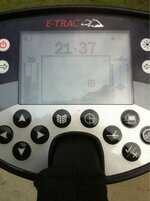HobbyMan
Jr. Member
- Sep 7, 2013
- 43
- 18
- Detector(s) used
- Minelab E-Trac, XP DEUS, Golden Mask 4 Pro, Teknetics Eurotek Pro 11'' DD
- Primary Interest:
- Metal Detecting
Hello friends!
I am opening this thread to share with you some video tests of my metal detectors. I have Minelab E-Trac, XP DEUS, Golden Mask 4 Pro and Teknetics Eurotek Pro and I am familiar with each of them. I have a lot of free time, so making tests and comparing the capabilities of my detectors is one of my hobbies. I will be glad to discus the capabilities of these detectors with you, as well I will be glad to answer on your questions, if you have some.
I am really impressed by the XP DEUS capabilities - very sensitive and fast detector, probably the best all around VLF metal detector, suitable even for gold prospecting. The best detector for iron infested sites.
I also love my E-Trak - it can go very deep, if you set the sensitivity manually. Very sensitive to silver. It is a pretty slow machine, but the discrimination is the best on the market.
Golden Mask 4 Pro is the most famous analogue 18 kHz metal detector in Europe - very robust construction, very easy for operation, sensitive to small objects, a nice two-tone discrimination with adjustable tones. It is not the deepest machine, but it is perfect for iron infested places and performs very well on heavy mineralized soils.
The Teknetics Eurotek Pro /11" DD Search Coil/ is a very nice easy to use metal detector, especially for the money. Very good discrimination. It is not the deepest and the fastest metal detector, but it is probably the best choice for a first machine with more then enough features. By my opinion it is the best metal detector in the $300 price range.
Here are my test videos:
XP DEUS test with gold nugget in the ground:
XP DEUS gold nugget air test:
XP DEUS depth test and deepest settings:
Minelab E-Trac Manual vs Auto Sensitivity:
XP DEUS and Golden Mask 4 Pro depth test:
I am opening this thread to share with you some video tests of my metal detectors. I have Minelab E-Trac, XP DEUS, Golden Mask 4 Pro and Teknetics Eurotek Pro and I am familiar with each of them. I have a lot of free time, so making tests and comparing the capabilities of my detectors is one of my hobbies. I will be glad to discus the capabilities of these detectors with you, as well I will be glad to answer on your questions, if you have some.
I am really impressed by the XP DEUS capabilities - very sensitive and fast detector, probably the best all around VLF metal detector, suitable even for gold prospecting. The best detector for iron infested sites.
I also love my E-Trak - it can go very deep, if you set the sensitivity manually. Very sensitive to silver. It is a pretty slow machine, but the discrimination is the best on the market.
Golden Mask 4 Pro is the most famous analogue 18 kHz metal detector in Europe - very robust construction, very easy for operation, sensitive to small objects, a nice two-tone discrimination with adjustable tones. It is not the deepest machine, but it is perfect for iron infested places and performs very well on heavy mineralized soils.
The Teknetics Eurotek Pro /11" DD Search Coil/ is a very nice easy to use metal detector, especially for the money. Very good discrimination. It is not the deepest and the fastest metal detector, but it is probably the best choice for a first machine with more then enough features. By my opinion it is the best metal detector in the $300 price range.
Here are my test videos:
XP DEUS test with gold nugget in the ground:
XP DEUS gold nugget air test:
XP DEUS depth test and deepest settings:
Minelab E-Trac Manual vs Auto Sensitivity:
XP DEUS and Golden Mask 4 Pro depth test:
Upvote
0







